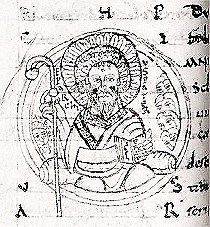|
Adémar De Chabannes
Adémar de Chabannes (988/989 – 1034; also Adhémar de Chabannes) was a French/Frankish monk, active as a composer, scribe, historian, poet, grammarian and forgery, literary forger. He was associated with the Abbey of Saint Martial, Limoges, where he was a central figure in the Saint Martial school, an important center of early medieval music. Much of his career was spent copying and transcribing earlier accounts of Frankish history; his major work was the ''Chronicon Aquitanicum et Francicum'' (''Chronicle of Aquitaine and France''). He is well-known for forging a ''Vita'', purportedly by Aurelian of Limoges, that indicated Saint Martial was one of the original Apostles in the New Testament, apostles, and for composing an associated Mass for Saint Martial. Though he successfully convinced the local bishop and abbot of its authenticity, the traveling monk Benedict of Chiusa exposed his forgery and damaged Adémar's reputation. Life and career Besides perhaps Guillaume de Mach ... [...More Info...] [...Related Items...] OR: [Wikipedia] [Google] [Baidu] |
Chronicon Aquitanicum
The ''Chronicon Aquitanicum'' is a set of annals covering the years 830 to 930 with several gaps and an added notice on the year 1025. It is found in the "great encyclopedia codex", BN lat. 5239, of the Abbey of Saint Martial at Limoges. Its entries are annotations on an Easter cycle. The ''Chronicon'' was first published by Philippe Labbe in 1653. It was next published in 1717 by Edmond Martène and Ursin Durand under the title ''Breve chronicon Normannicum sive Britannicum'' ("Short Chronicle of the Northmen, or Britons"). Georg Pertz edited it for a third time for the ''Monumenta Germaniae Historica'' in 1829, using the title by which it is most commonly known. The ''Chronicon'' draws on the ''Annales Engolismenses'' for much of its information. Both sets of annals were used by Adhemar of Chabannes in composing his ''Historiae''. In 1025, while copying from BN lat. 5239, he added marginal notes of his own to the codex. He returned to Limoges in 1026/7 to add a notice fo ... [...More Info...] [...Related Items...] OR: [Wikipedia] [Google] [Baidu] |
Annales Regni Francorum
The ''Royal Frankish Annals'' (Latin: ''Annales regni Francorum''), also called the ''Annales Laurissenses maiores'' ('Greater Lorsch Annals'), are a series of annals composed in Latin in Carolingian Francia, recording year-by-year the state of the monarchy from 741 (the death of Charles Martel) to 829 (the beginning of the crisis of Louis the Pious). Their authorship is unknown, though Wilhelm von Giesebrecht suggested that Arno of Salzburg was the author of an early section surviving in the copy at Lorsch Abbey. The Annals are believed to have been composed in successive sections by different authors, and then compiled.Scholz “Introduction” ''Carolingian Chronicles'' p. 5 The depth of knowledge regarding court affairs suggests that the annals were written by persons close to the king, and their initial reluctance to comment on Frankish defeats betrays an official design for use as Carolingian propaganda. Though the information contained within is heavily influenced by ... [...More Info...] [...Related Items...] OR: [Wikipedia] [Google] [Baidu] |
Fredegar
The ''Chronicle of Fredegar'' is the conventional title used for a 7th-century Franks, Frankish chronicle that was probably written in Burgundy. The author is unknown and the attribution to Fredegar dates only from the 16th century. The chronicle begins with the creation of the world and ends in AD 642. There are also a few references to events up to 658. Some copies of the manuscript contain an abridged version of the chronicle up to the date of 642, but include additional sections written under the Carolingian dynasty that end with the death of Pepin the Short in 768. The ''Chronicle of Fredegar'' with its ''Continuations'' is one of the few sources that provide information on the Merovingian dynasty for the period after 591 when Gregory of Tours' the ''Decem Libri Historiarum'' finishes. Authorship None of the surviving manuscripts specify the name of the author. The name "Fredegar" (modern French Frédégaire) was first used for the chronicle in 1579 by Claude Fauchet ( ... [...More Info...] [...Related Items...] OR: [Wikipedia] [Google] [Baidu] |
Pharamond
Pharamond, also spelled Faramund, is a legendary early king of the Franks, first referred to in the anonymous 8th-century '' Liber Historiae Francorum'', which depicts him as the first king of the Franks. Historical sources and scholarship Pharamond first appears in the '' Liber Historiae Francorum'', commonly dated to 727. After relating the legendary Trojan origin of the Franks (which is copied in main from the Chronicle of Fredegar), the ''Liber'' reports that after the death of the Frankish leader Sunno, his brother Marcomer proposed to the Franks that they should have one single king, contrary to their tradition. The ''Liber'' adds that Pharamond, named as Marcomer's son, was chosen as "long-haired" (''crinitus'') king. When he died, his son Chlodio was raised up as the next king. Because there is no reference to Pharamond in any source prior to this work, scholars generally consider him a legendary rather than historical figure. In contrast to his depiction as a sole k ... [...More Info...] [...Related Items...] OR: [Wikipedia] [Google] [Baidu] |
Saint Cybard
Saint Cybard (or Eparchius, Eparque, Ybar, Ybard, Separchius, Cybar; 504 – 1 July 581) was a monk and a hermit who inhabited a cave beneath the walls of Angoulême for forty-four years. The Latin form of his name is ''Eparchius'', and it also appears in French as ''Éparche'' and ''Ybars'', as in the commune of Saint-Ybars. Life Cybard was probably born at Trémolat in the Périgord. He was ordained a priest by Aptonius III, the Bishop of Angoulême, in 542. His story is told in Gregory of Tours ''Historia Francorum'' (VI, 8). An anonymous hagiography entitled ''Vita et virtutes Eparchii reclusi Ecolismensis'' ("The life and virtues of Eparchius the recluse of Angoulême") tells how "alone he ... walked by night to the spot where he should be a recluse. Having finished his journey and his prayers, he lay down his head on a rock." That spot was, according to the same source, at "a remote location, far from the city, and from above on the side of the mountain trickled a stream of f ... [...More Info...] [...Related Items...] OR: [Wikipedia] [Google] [Baidu] |
Pilgrimage
A pilgrimage is a travel, journey to a holy place, which can lead to a personal transformation, after which the pilgrim returns to their daily life. A pilgrim (from the Latin ''peregrinus'') is a traveler (literally one who has come from afar) who is on a journey to a holy place. Typically, this is a physical journey (often on foot) to some place of special significance to the adherent of a particular religious belief system. Background Pilgrimages frequently involve a journey or search of morality, moral or spirituality, spiritual significance. Typically, it is a journey to a shrine or other location of importance to a person's beliefs and faith, although sometimes it can be a metaphorical journey into someone's own beliefs. Many religions attach spiritual importance to particular places: the place of birth or death of founders or saints, or to the place of their "calling" or spiritual awakening, or of their connection (visual or verbal) with the divine, to locations where ... [...More Info...] [...Related Items...] OR: [Wikipedia] [Google] [Baidu] |
Jerusalem
Jerusalem is a city in the Southern Levant, on a plateau in the Judaean Mountains between the Mediterranean Sea, Mediterranean and the Dead Sea. It is one of the List of oldest continuously inhabited cities, oldest cities in the world, and is considered Holy city, holy to the three major Abrahamic religions—Judaism, Christianity, and Islam. Both Israel and Palestine claim Jerusalem as their capital city; Israel maintains its primary governmental institutions there, while Palestine ultimately foresees it as its seat of power. Neither claim is widely Status of Jerusalem, recognized internationally. Throughout History of Jerusalem, its long history, Jerusalem has been destroyed at least twice, Siege of Jerusalem (other), besieged 23 times, captured and recaptured 44 times, and attacked 52 times. According to Eric H. Cline's tally in Jerusalem Besieged. The part of Jerusalem called the City of David (historic), City of David shows first signs of settlement in the 4th ... [...More Info...] [...Related Items...] OR: [Wikipedia] [Google] [Baidu] |
Angoulême
Angoulême (; Poitevin-Saintongeais: ''Engoulaeme''; ) is a small city in the southwestern French Departments of France, department of Charente, of which it is the Prefectures of France, prefecture. Located on a plateau overlooking a meander of the river Charente (river), Charente, the city is nicknamed the "balcony of the southwest". The city proper's population is a little less than 42,000 but it is the centre of an urban area of 110,000 people extending more than from east to west. Formerly the capital of Angoumois during the Ancien Régime, Angoulême was a fortified town for a long time, and was highly coveted due to its position at the centre of many roads important to communication, so therefore it suffered many sieges. From its tumultuous past, the city, perched on a rocky spur, inherited a large historical, religious, and urban heritage which attracts a lot of tourists. Nowadays, Angoulême is at the centre of an agglomeration, which is one of the most industrialised ... [...More Info...] [...Related Items...] OR: [Wikipedia] [Google] [Baidu] |
Saint-Cybard
The Abbey of Saint-Cybard was a Benedictine monastery located just outside the northern city walls of Angoulême. According to Gregory of Tours in the ''Historia Francorum'' (VI, 8), the monastery was founded by Saint Eparchius in the sixth century. Little is known about the institution after its founding until 852, when King Charles the Bald confirmed a series of gifts to the abbey made by Abbot Launus, who was also the bishop of Angoulême. The Abbey suffered along with other monasteries and cities of the region during the Viking raids of the ninth century, being sacked in 875. It adopted the Benedictine rule in 938. Between 1075 and 1087 Count Fulk of Angoulême handed Saint-Cybard over to the Cluniac abbey of Saint-Jean-d'Angély. While Saint-Jean's abbot was to appoint the abbot of Saint-Cybard, it was not until 1098 or 1099 when the monks of Saint-Cybard were forced to accept the arrangement. This relationship ended in 1161.Musset, "Cartulaire de Saint-Jean-d’Angély t.2 ... [...More Info...] [...Related Items...] OR: [Wikipedia] [Google] [Baidu] |





